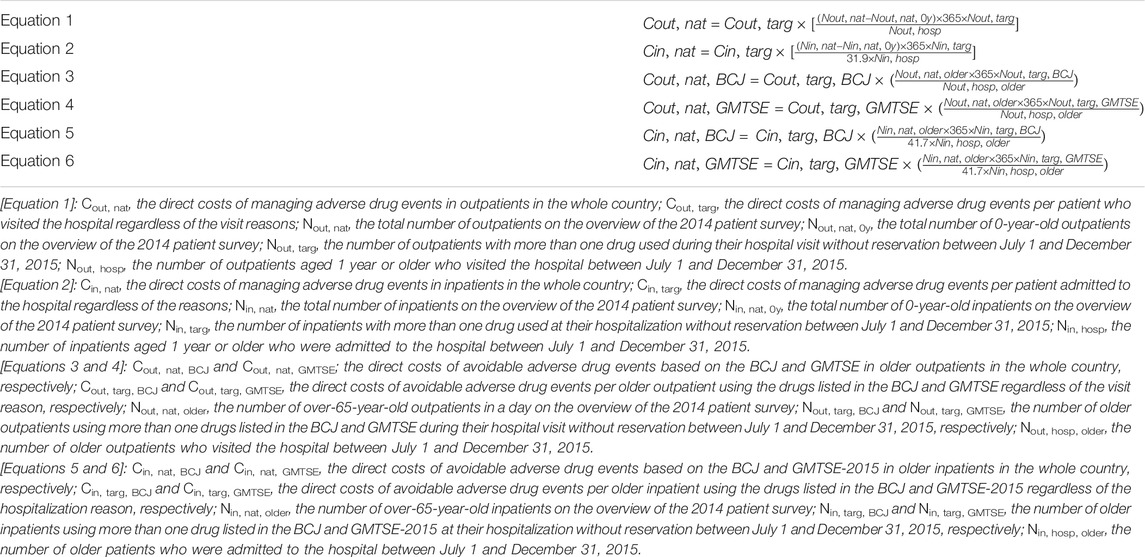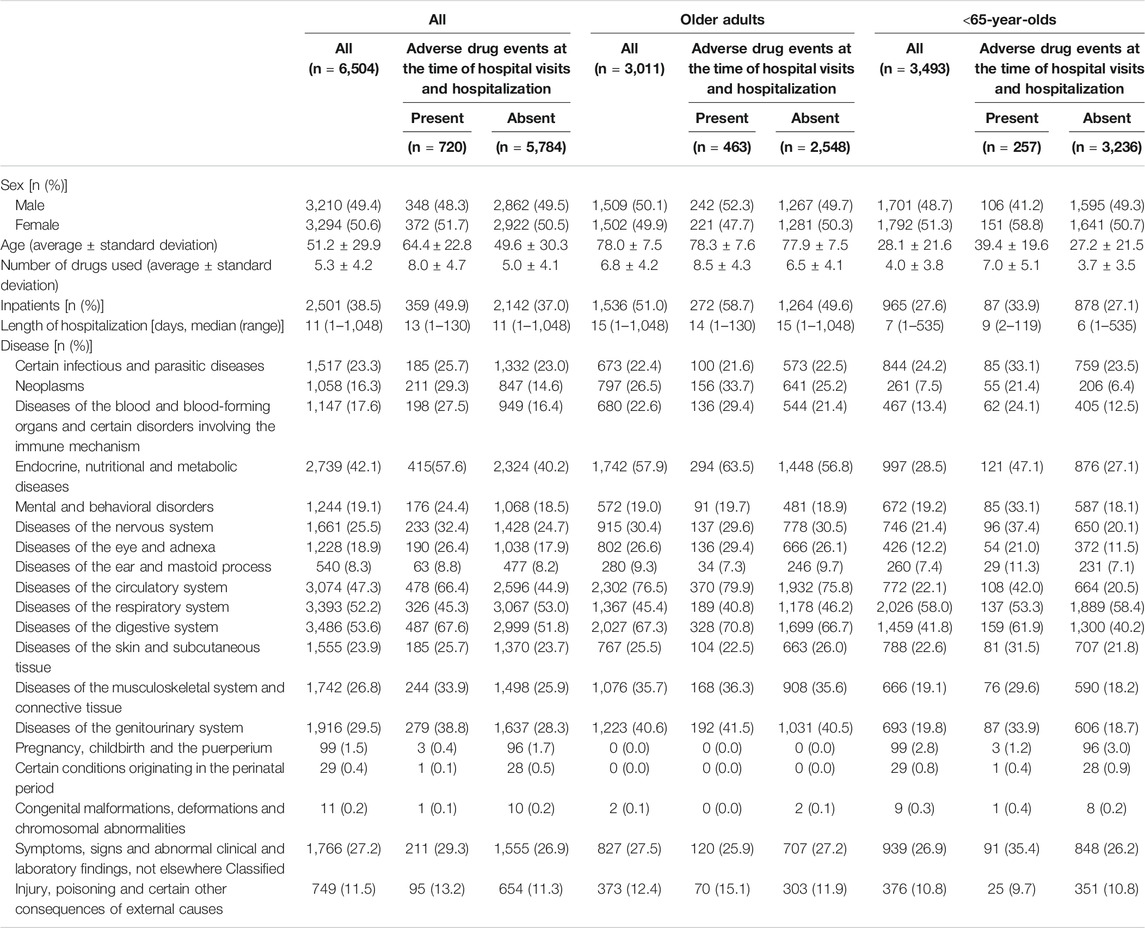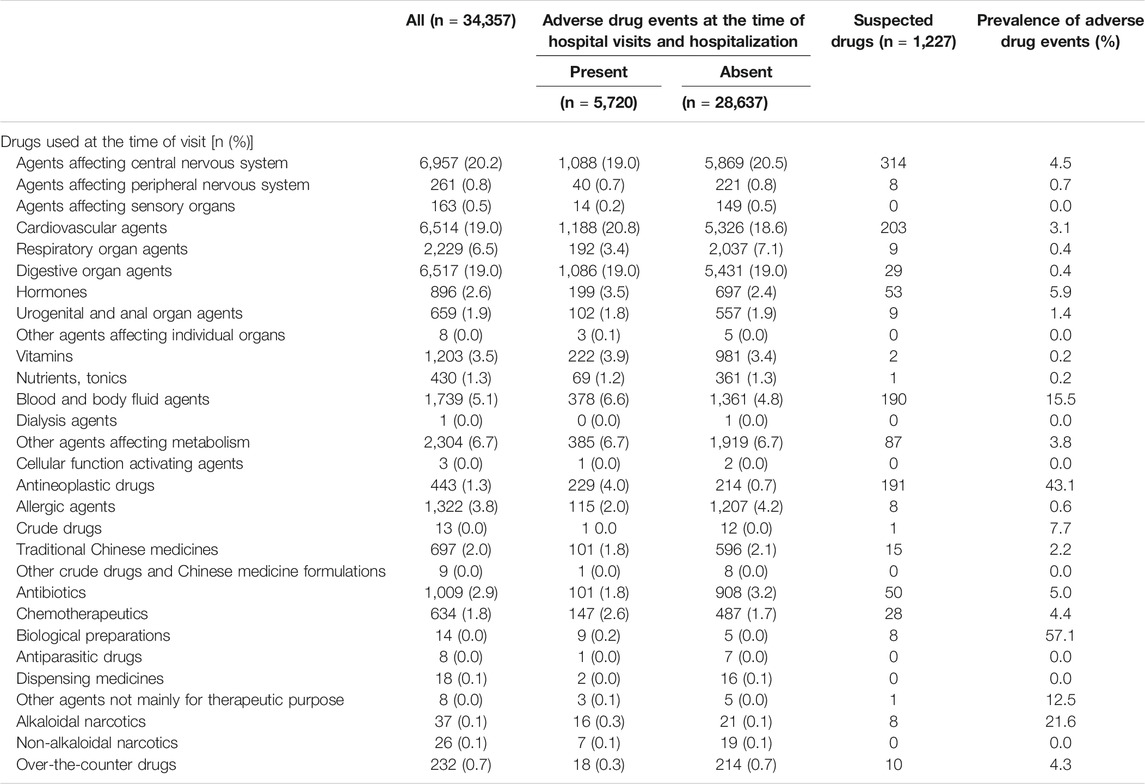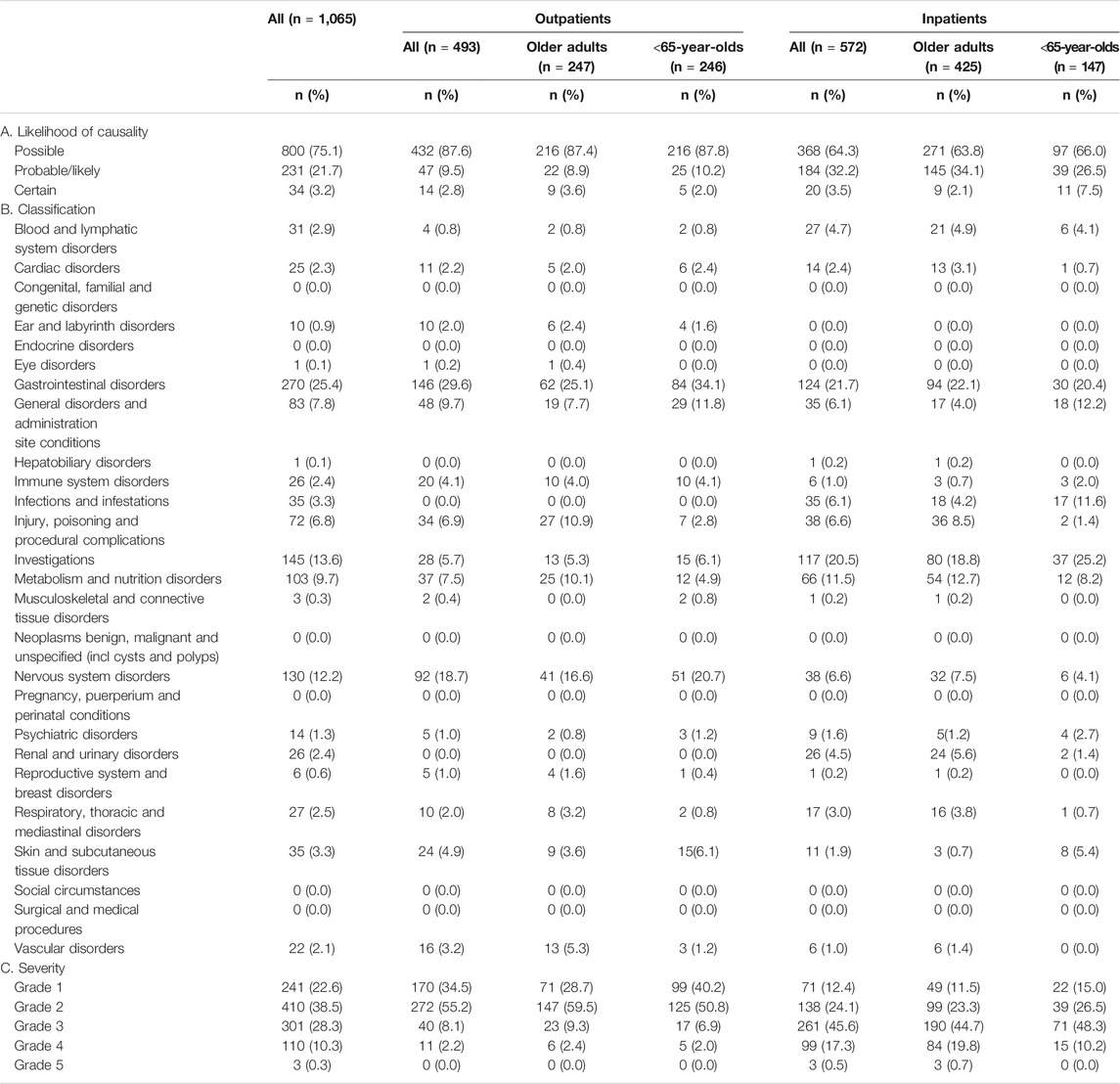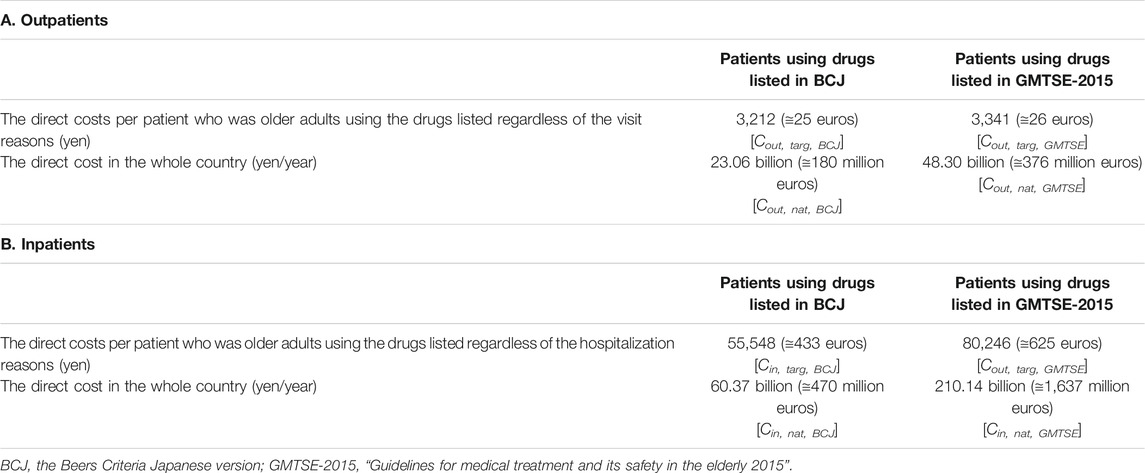- 1Laboratory of Clinical Pharmacy, Gifu Pharmaceutical University, Gifu, Japan
- 2Department of Pharmacy, Gifu Municipal Hospital, Gifu, Japan
- 3Laboratory of Community Health Pharmacy, Gifu Pharmaceutical University, Gifu, Japan
In Japan, medical costs are increasing annually, and the increase in national medical costs, particularly in the direct cost of managing adverse drug events, is high. An in-depth understanding of these costs is important for their reduction. This study aimed to calculate the direct cost of managing adverse drug events in all ages, including older adults, and that of avoidable adverse drug events in older adults. We conducted a retrospective survey on patients aged 1 year or older who visited Gifu Municipal Hospital in Japan. We investigated and calculated the direct cost of managing adverse drug events and that of avoidable adverse drug events based on the Beers Criteria Japanese version (BCJ) and “Guidelines for medical treatment and its safety in the elderly 2015” (GMTSE-2015) in inpatients and outpatients. Among 6,504 patients, 11.1% visited the hospital or were hospitalized due to adverse drug events. The direct costs per patient with adverse drug events were 21,281 and 22,590 yen (166 and 176 euros as on September 13, 2021) for outpatients, and 853,175 and 874,582 yen (6,648 and 6,815 euros) for inpatients of all ages and older adults, respectively. The direct costs of avoidable adverse drug events per patient using drugs listed in the BCJ and GMTSE-2015 for older adults were 3,212 and 3,341 yen (25 and 26 euros) for outpatients, and 55,548 and 80,246 yen (433 and 625 euros) for inpatients, respectively. In sum, considering both inpatients and outpatients in the whole country, the direct costs of managing adverse drug events were 804.53 billion and 597.19 billion yen (6,269 million and 4,653 million euros) per year for all ages and older ages, respectively. The direct cost of avoidable adverse drug events in older adults was 83.43–258.44 billion yen (650–2,013 million euros) per year. We found that, in Japan, high medical costs are often caused by managing adverse drug events, and that the costs of avoidable adverse drug events in older adults based on the BCJ and GMTSE-2015 account for a substantial proportion of the medical cost. Therefore, by using the BCJ and GMTSE-2015, avoiding adverse drug events and reducing medical costs may be possible.
Introduction
Globally, medical costs are increasing annually (The Organisation for Economic Co-operation and Development, 2021). In the United States and Japan, the national medical costs in 2015 were 3,051,508 million dollars and 42,364.4 billion yen, representing an increase of 5.9 and 3.8% from the previous year, respectively (Ministry of Health, Labour and Welfare in Japan, 2015; The Organisation for Economic Co-operation and Development, 2021). In Japan, medical costs for adults aged 65 and over, which were 25,127.6 billion yen, increased by 5.1% from the previous year, and those for older adults exceeded 50% of the total medical costs (Ministry of Health, Labour and Welfare in Japan, 2015). Thus, measures to reduce these ever-increasing medical costs should be taken.
A substantial proportion of hospital consultations is attributable to adverse drug events. During 1990–2020, the proportion of outpatient visits and hospitalizations due to adverse drug events has varied from 5.5 to 35.0% (Hanlon et al., 1997; Honigman et al., 2001; Gandhi et al., 2003) and 1.3 to 30.4% (Dartnell et al., 1996; Chan et al., 2001; Senst et al., 2001; Onder et al., 2002; Wawruch et al., 2009; Ruiter et al., 2012; Parameswaran Nair et al., 2017), respectively. In Japan, 1.7% of hospitalizations are attributable to inappropriate drug use (Koinuma et al., 2006). The prevalence of adverse drug events resulting in hospital consultations is a relevant factor of the high costs of managing adverse drug events in hospitals. Therefore, every country calculates the direct costs of managing adverse drug events, including treatment and examination, which were evaluated to be quite high (Bates et al., 1997; Carrasco-Garrido et al., 2010; Leendertse et al., 2011; Rottenkolber et al., 2011; Stark et al., 2011). However, there are no data for Japan; therefore, it is important to evaluate the cost in Japan. It is important to clarify the costs of managing adverse drug events and to evaluate the contribution of the costs to overall medical costs.
Studies have been conducted to determine which drugs should be avoided and discontinued by older adults (Opondo et al., 2012; Wickop and Langebrake, 2014; Lucchetti and Lucchetti, 2017; Nothelle et al., 2017), and results have shown that 2.9–38.5% of older adults’ prescriptions are potentially inappropriate (Opondo et al., 2012). To determine which drugs should be avoided and discontinued by the elderly, the Beers Criteria Japanese version (BCJ) was published by the National Institute of Public Health in 2008 (National Institute of Public Health, 2010), and the “Guidelines for medical treatment and its safety in the elderly 2015” (hereinafter referred to as GMTSE-2015) was published by the Japan Geriatrics Society in 2015 (The Japan Geriatrics Society, 2015; Kojima et al., 2016). In the previous study, we investigated the prevalence of older patients targeted by the BCJ and GMTSE-2015, and we clarified the prevalence and background/factor of adverse drug events occurred (Tachi et al., 2019). The avoidance of adverse drug events by appropriate prescriptions results in a reduction of cost of managing adverse drug events. The calculation of costs of preventable adverse drug events is important to understand its effect on overall medical costs. This calculated cost has been reported (Rothschild et al., 2002; Leendertse et al., 2011; Slight et al., 2018). The costs that can be reduced by using the criteria for drugs that should be avoided and considered for discontinuation by older adults, such as those listed in the BCJ and GMTSE-2015, should also be identified in Japan.
We conducted a retrospective survey with patients who visited a hospital in Japan to calculate the direct cost of managing adverse drug events. Further, we calculated the degree of this reduction using the BCJ and GMTSE-2015 as references.
Materials and Methods
Participants
The target patients were outpatients and inpatients aged at least 1 year who visited Gifu Municipal Hospital (Gifu, Japan), excluding outpatients and inpatients with reservations, between July 1 and December 31, 2015, and took one or more drugs, excluding investigational drugs, during the visit. Patients hospitalized immediately after their hospital visit as outpatients were included as inpatients.
With 609 beds, Gifu Municipal Hospital is a typical general hospital in Japan, providing primary and secondary care to the city of Gifu and its suburbs.
Investigations and Evaluations
The survey was conducted retrospectively using electronic medical records. The survey items were sex, age, drugs used at the time of hospital visit or hospitalization, disease, presence or absence of adverse drug events, and length of hospitalization in case of inpatients. For people aged 65 years and above, we investigated whether they used the drugs listed in the BCJ and GMTSE-2015.
Drugs were classified according to the YJ code (unique code for each item listed on the NHI drug price standard) used in Japanese insurance claims. Meanwhile, diseases were classified using the International Statistical Classification of Diseases and Related Health Problems 10th Revision (ICD-10) (World Health Organization, 2016).
Adverse drug events were extracted in accordance with the Global Trigger Tool (Institute for Healthcare Improvement, 2003), and events’ severity was evaluated using the Common Terminology Criteria for Adverse Events Version 5.0 (Japan Clinical Oncology Group, 2017). The causality was categorized into “possible,” “probable/likely,” and “certain,” using the Causality Assessment System published by Uppsala Monitoring Centre (UMC) (World Health Organization – Uppsala Monitoring Centre, 2012). Two pharmacists with at least 10 years of clinical experience and, where necessary, a physician determined these adverse drug events and classified their severity and causality.
Calculation of Direct Costs of Managing Adverse Drug Events
In this study, we evaluated direct costs from the perspective of medical cost payers under the public medical insurance system. The direct costs of managing adverse drug events were evaluated in outpatients who visited the hospital due to such events and inpatients who were admitted to the hospital due to the same. Direct costs due to avoidable adverse drug events in older adults were evaluated in older patients who visited (outpatients) or were admitted to (inpatients) the hospital due to adverse drug events caused by the drugs listed in the BCJ and GMTSE-2015. For those who visited or were admitted to the hospital for reasons other than adverse drug events, the direct costs were recorded as 0 yen.
We calculated the direct costs by stratifying outpatients and inpatients because information on the numbers of outpatients and inpatients is available in Japan’s domestic statistical data (Ministry of Health, Labour and Welfare in Japan, 2014). The direct costs were extrapolated to the national level (whole country) by linear regression, based on an overview of the 2014 patient survey (Ministry of Health, Labour and Welfare in Japan, 2014). Please see the detailed calculations in Supplementary Material.
Direct Costs of Managing Adverse Drug Events in Outpatients
For all ages, older adults (>65-year-olds), and <65-year-olds, we calculated the direct costs of managing adverse drug events per patient who visited the hospital due to these events (the sum of the direct cost for outpatients with adverse drug events divided by the number of outpatients with adverse drug events) (Cout, ade). In addition, we calculated the direct costs of managing adverse drug events per patient who visited the hospital regardless of the visit reason (the sum of the direct cost for outpatients with adverse drug events divided by the number of all outpatients targeted in this study) (Cout, targ). We then obtained the direct costs of managing adverse drug events in outpatients in the whole country (Cout, nat) using Equation 1; (Table 1).
Direct Costs of Managing Adverse Drug Events in Inpatients
For all ages, older adults, and <65-year-olds, we calculated the direct costs of managing adverse drug events per patient admitted to the hospital due to these events (the sum of the direct cost for inpatients with adverse drug events divided by the number of outpatients with adverse drug events) (Cin, ade). In addition, we calculated the direct costs of managing adverse drug events per patient admitted to the hospital regardless of the reason (the sum of the direct cost for inpatients with adverse drug events divided by number of all inpatients targeted in this study) (Cin, targ). When then obtained the direct costs of managing adverse drug events in inpatients in the whole country (Cin, nat) using Equation 2; (Table 1).
Direct Cost of Avoidable Adverse Drug Events in Older Outpatients
For the older outpatients who used the drugs listed in the BCJ and GMTSE-2015, we calculated the direct costs of avoidable adverse drug events per older outpatient using the drugs listed in the BCJ and GMTSE-2015 regardless of the visit reason (the sum of the direct cost in older outpatients with adverse drug events due to the drugs listed in the BCJ and GMTSE-2015 divided by the number of all the older outpatients who used the drugs listed in the BCJ and GMTSE-2015 targeted in this study) (Cout, targ, BCJ and Cout, targ, GMTSE, respectively). We then obtained the direct costs of avoidable adverse drug events based on the BCJ and GMTSE-2015 in older outpatients in the whole country [Cout, nat, BCJ and Cout, nat, GMTSE) using Equations 3 and 4] (Table 1).
Direct Cost of Avoidable Adverse Drug Events in Older Inpatients
For the older inpatients who used the drugs listed in the BCJ and GMTSE-2015, we calculated the direct costs of avoidable adverse drug events per older inpatient using the drugs listed in the BCJ and GMTSE-2015 regardless of the hospitalization reason (the sum of the direct cost of adverse drug events in older inpatients due to the drugs listed in the BCJ and GMTSE-2015 divided by the number of all the older inpatients targeted in this study who used the drugs listed in the BCJ and GMTSE-2015) (Cin, targ, BCJ and Cin, targ, GMTSE, respectively). We then obtained the direct costs of avoidable adverse drug events based on the BCJ and GMTSE-2015 in older inpatients in the whole country (Cin, nat, BCJ and Cin, nat, GMTSE) using Equations 5 and 6; (Table 1).
Ethical Considerations
This study was approved by the ethics committee of Gifu Municipal Hospital (approval number: 349) and Gifu Pharmaceutical University (approval number: 28–8).
Results
Analysis for All Ages, Older Adults, and <65-Year-Olds
Patient Characteristics
Table 2 shows the patient characteristics for all ages, older adults, and <65-year-olds. Among all ages, 49.4% were male, the age was 51.2 ± 29.9 years (mean ± standard deviation), and the number of drugs used was 5.3 ± 4.2. The most common disease was “diseases of the digestive system” (53.6%). Among older adults, 50.1% were male, the age was 78.0 ± 7.5 years, and the number of drugs used was 6.8 ± 4.2. The most common disease was “diseases of the circulatory system” (76.5%).
Adverse Drug Events
Among the patients surveyed, 11.1% (720/6,504) visited the hospital and were hospitalized due to adverse drug events. The total number of adverse drug events that led to visits was 1,065, which included multiple adverse drug events at the time of hospital visits and hospitalization.
Table 3 shows the drug categories. The prevalence of adverse drug events was the highest for biological preparations (57.1%), followed by antineoplastic drugs (43.1%) and alkaloidal narcotics (21.6%). The prevalence of adverse drug events was 4.3% for over-the-counter drugs.
Table 4 shows the likely causality, classification, and severity of adverse drug events. Most events were “possible” (75.1%), classified as “gastrointestinal disorders” (25.4%), and “grade 2” (38.5%), respectively.
Direct Costs for Management of Adverse Drug Events
Table 5 shows the direct costs of managing adverse drug events in outpatients. The direct costs per patient who visited the hospital due to adverse drug events (Cout, ade) were 21,281 and 22,590 yen (166 and 176 euros as on September 13, 2021) for all ages and older adults, respectively.
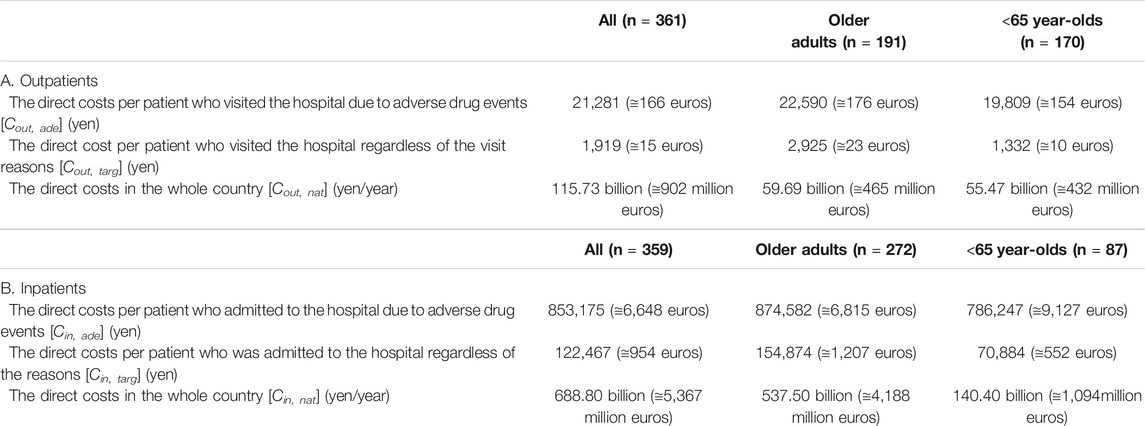
TABLE 5. Direct costs for management of adverse drug events (all ages, older adults and < 65 year-olds).
For all ages, the direct cost per patient who visited the hospital regardless of the visit reasons (Cout, targ) was 1,919 yen (15 euros), and the direct cost in the whole country (Cout, nat) was 115.73 billion yen (902 million euros) per year. For older adults, the direct cost per patient who visited the hospital regardless of the visit reasons (Cout, targ) was 2,925 yen (23 euros), and the direct cost in the whole country (Cout, nat) was 59.69 billion yen (465 million euros) per year.
Table 5 shows the direct costs of managing adverse drug events in inpatients. The direct costs per patient admitted to the hospital due to adverse drug events (Cin, ade) were 853,175 and 874,582 yen (6,648 and 6,815 euros) for all ages and older adults, respectively.
For all ages, the direct cost per patient admitted to the hospital regardless of hospitalization reasons (Cin, targ) was 122,467 yen (954 euros) and that of the whole country (Cin, nat) was 688.80 billion yen (5,367 million euros) per year. For older adults, the direct cost per patient who was admitted to the hospital regardless of the hospitalization reasons (Cin, targ) was 154,874 yen (1,207 euros), and at the country level, it was (Cin, nat) was 537.50 billion yen (4,188 million euros) per year.
In sum, combining inpatients and outpatients, the direct costs of managing adverse drug events were 804.53 billion yen (6,269 million euros) per year for all ages and 597.19 billion yen (4,654 million euros) per year for older ages for the whole country.
Analysis of Patients Who Used the Drugs Listed in the BCJ and GMTSE-2015
Patient Characteristics
Table 6 shows the background of older adults who used the drugs listed in the BCJ and GMTSE-2015. The most common diseases among outpatients according to the BCJ were related to the circulatory system (90.2%), and those according to GMTSE-2015 were related to the digestive system (88.0%). The prevalence of adverse drug events in outpatients was 3.3% (17/519) and 5.6% (59/1,045) according to the BCJ and GMTSE-2015, respectively. The most common diseases among inpatients, according to both the BCJ and the GMTSE-2015, were related to the circulatory system (77.8 and 76.5%, respectively). The prevalence of adverse drug events in inpatients was 4.8% (23/481) and 9.2% (107/1,159) according to the BCJ and GMTSE-2015, respectively.
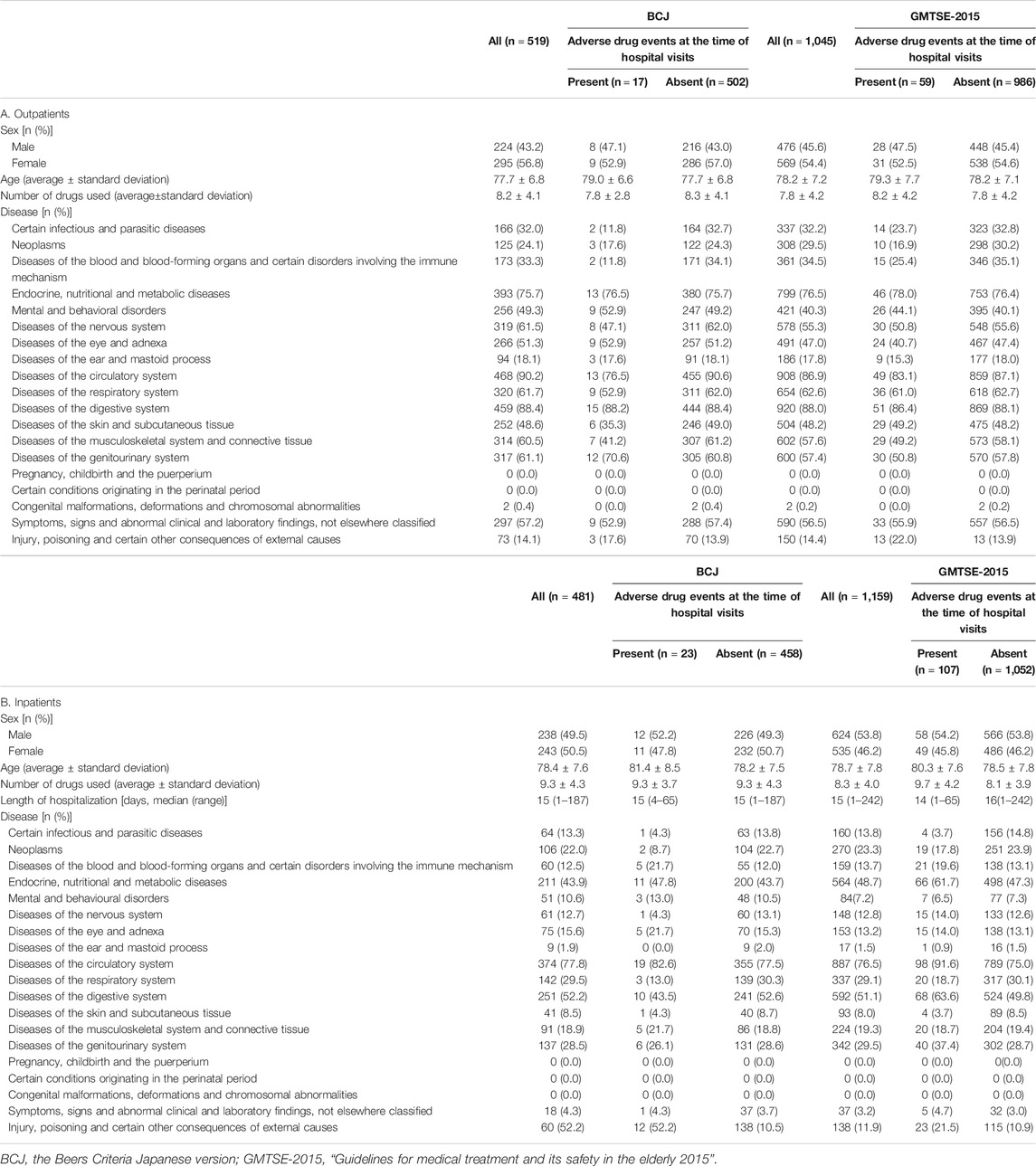
TABLE 6. Background of patients with the drugs listed in the Beers Criteria Japanese version and “Guidelines for medical treatment and its safety in the elderly 2015”.
Calculation of Cost of Avoidable Adverse Drug Events in Older Adults
Table 7 shows the direct cost of avoidable adverse drug events in older adults based on the BCJ and the GMTSE-2015. For the patients using drugs listed in the BCJ and GMTSE-2015, the direct costs of avoidable adverse drug events per patient (Cout, targ, BCJ and Cout, targ, GMTSE) were 3,212 and 3,341 yen (25 and 26 euros) for outpatients and the direct costs (Cin, targ, BCJ and Cin, targ, GMTSE) were 55,548 and 80,246 yen (433 and 625 euros) for inpatients, respectively. Meanwhile, the direct costs for the whole country per year (Cout, nat, BCJ and Cout, nat, GMTSE) were 23.06 billion and 48.30 billion yen (180 million and 376 million euros) for outpatients and the direct costs (Cin, nat, BCJ and Cin, nat, GMTSE) were 60.37 billion and 210.14 billion yen (470 and 1,637 million euros) for inpatients, respectively.
On combining inpatients and outpatients, the direct cost of avoidable adverse drug events in older adults was 83.43–258.44 billion yen (650–2,014 million euros) per year for the whole country.
Discussion
We conducted a retrospective survey to evaluate the direct cost of managing adverse drug events and the potential reduction of direct costs using the BCJ and GMTSE-2015.
Adverse drug events were the reason for 9.0% of all outpatient visits in Japan. This is consistent with the findings of various other studies reporting that adverse drug events are the reason for 5.5–53% of outpatient visits (Hanlon et al., 1997; Honigman et al., 2001; Gandhi et al., 2003). Furthermore, they accounted for 14.4% of all hospitalizations in this study, which is higher than the finding of another Japanese study that reported only 1.7% of hospitalizations owing to adverse drug events (Koinuma et al., 2006). This is probably because the report by Koinuma was limited to adverse drug events due to inappropriate prescription. Further, the number of visits due to adverse drug events caused by antineoplastic drugs increased with outpatient cancer chemotherapy. However, the current findings are in line with various reports worldwide; that is, the rate of hospitalization due to adverse drug events ranges from 1.3 to 30.4% (Dartnell et al., 1996; Chan et al., 2001; Onder et al., 2002; Wawruch et al., 2009; Ruiter et al., 2012; Parameswaran Nair et al., 2017).
During a medical economic assessment, direct costs of medical resources are estimated using the so-called micro-costing method (Gold et al., 1996; Drummond et al., 2005). The micro-costing method calculates the sum of the direct costs of each clinic/technical fee including medical supplies and drugs. Japan’s public medical insurance system is mainly based on the conception of the micro-costing method. In Japan’s public medical insurance system, outpatient costs are paid through fees-for-service whereas inpatient costs are paid for by the coexistence of package pricing and fee-for-service. In this study, we evaluated the direct costs from the perspective of medical cost payers under the public medical insurance system. From this perspective, the direct cost of managing adverse drug events corresponds to the total costs payable by patients and/or health insurance association pertaining to the hospital visit and hospitalization caused by adverse drug events. The direct cost of managing adverse drug events considered to be 0 yen when the reason for the hospital visit and hospitalization is not due to adverse drug events.
The direct cost per patient who visited the hospital due to adverse drug events was 21,281 yen, which is somewhat similar to that of Germany (381 euros, that is, 48,893 yen) (Stark et al., 2011). In contrast, the direct cost per patient admitted to the hospital due to adverse drug events was 853,175 yen. Meanwhile, in the Netherlands, Spain, and Germany, the direct cost per patient admitted to the hospital due to adverse drug events was 6,009 euros, 3,857–4,656 euros, and 2,250 euros (771,134 yen, 494,968–597,504 yen, 288,743 yen, respectively) (Carrasco-Garrido et al., 2010; Leendertse et al., 2011; Rottenkolber et al., 2011). Although this study’s result is slightly similar to that of these previous studies, it is higher than that of the German report, probably because the latter was limited to internal medicine inpatients. In addition, the methods for calculating hospitalization cost in Japan differ from those in other countries.
In this study, which combined inpatients and outpatients, the direct costs of managing adverse drug events were 804.53 billion yen (6,269 million euros) per year for all ages in Japan. In the Netherlands, the direct cost of managing adverse drug events in inpatients was about 94 million euros (12 billion yen) annually in 2011(Leendertse et al., 2011). In Spain, this annual cost was about 226–273 million euros (29–35 billion yen) for inpatients in 2010 (Carrasco-Garrido et al., 2010), while in Germany it was 816 million euros (105 billion yen) for outpatients in 2011 (Stark et al., 2011). Because the medical and technical fee differs in each country, the calculated costs cannot be accurately compared each other. However, the cost in Japan in this study was slightly high compared with those countries when the costs were corrected according to total population of those countries. That would be due to a larger population of older people in Japan than in those countries.
Older people are more likely to experience adverse drug events due to decreased physiological function (Mangoni and Jackson, 2004). Risk factors for adverse drug events in older adults include polypharmacy, dementia, reduced visual acuity, renal damage, and liver damage (The Japan Geriatrics Society, 2015). In particular, polypharmacy is an important risk factor of adverse drug events resulting in outpatient visits and hospitalization (Matsuyama et al., 2021). To prevent adverse drug events, the BCJ and GMTSE-2015 have begun to be used to suggest appropriate prescription drugs, reduce the use of drugs with a high risk of adverse events, and propose alternative drugs with lower risk. In this study, we calculated the direct cost of avoidable adverse drug events using the BCJ and GMTSE-2015 as references.
For the patients using drugs listed in the BCJ and GMTSE-2015, the direct costs of managing adverse drug events per patient were 3,212–3,341 and 55,548–80,246 yen (25–26 and 433–625 euros) for outpatients and inpatients, respectively. Meanwhile, the direct costs for the entire country per year were 23.06–48.30 and 60.37–210.14 billion yen (180–376 and 470–1,637 million euros) for outpatients and inpatients, respectively. A previous study of patients who used the drugs listed in the BCJ and GMTSE-2015 showed that the direct cost of managing adverse drug events per patient was 497–798 and 1,109–13,371 yen (4–6 and 9–104 euros) for outpatients and inpatients, respectively, and the direct costs for the whole country per year were 267.87–381.42 and 2.18–79.42 billion yen (2,087–2,972 and 17–619 million euros) for outpatients and inpatients, respectively (Tachi et al., 2019).
Medical costs for older adults are 25,127.6 billion yen (196 billion euros) per year in Japan (Ministry of Health, Labour and Welfare in Japan, 2015), while the direct costs of managing adverse drug events in older adults were 804.53 billion yen (6,269 million euros) for all ages, suggesting that the direct costs account for a certain proportion of the medical cost in Japan.
The proportion of the direct costs in the whole country for patients with adverse drug events due to drugs listed in the BCJ and GMTSE-2015 to those due to all kinds of drugs was 14.0% (83.43/597.19) to 43.3% (258.44/597.19) in older adults (outpatients and inpatients). A previous study in Japan indicates that polypharmacy is an induction risk factor of adverse drug events resulting in outpatient visits and hospitalization (Matsuyama et al., 2021). Therefore, adverse drug events resulting in outpatient visits and hospitalization should be avoided through prescription optimization and changing, reducing, and discontinuing the BCJ- and GMTSE-2015-listed drugs as needed. Of course, not all calculated costs of the adverse events through the BCJ and GMTSE-2015 would be reduced in actuality because other costs such as the lack of therapy and other adverse events caused by substitute drugs might occur due to the changed, reduced or discontinued prescription. Cost reduction based on the prevention of adverse drug events in older adults through the BCJ and GMTSE-2015 would be one of practical approach to reduce the costs of adverse drug events and eventually, reduce overall medical costs.
This study’s limitation is that it is a retrospective survey using electronic medical records that was conducted at only one general hospital in one region. The number of patients included in this study was small compared to that in the study using dataset of health insurance and claims. However, the smaller sample included detailed background of patients and adverse drug events, which are not available in the dataset of health insurance and claims. In addition, in this study, the extrapolation of the cost in the sample to the national cost was rough. To resolve the ensuring problems, Slight et al. reported a better and more defendable approach, which involves estimating the population-adjusted costs per patient and population-adjusted adverse drug events nationally, followed by an extrapolation (Slight et al., 2018). In Japan, the public medical insurance system covers the medical care of the whole nation and the Japanese government does not publicize the dataset of attributes of outpatients and inpatients of the whole nation. Therefore, we could not adjust extrapolation, for example, through multi-variate analysis. However, we consider the unadjusted extrapolation acceptable in this study for the three reasons below. First, from the patient survey in 2014 (Ministry of Health, Labour and Welfare in Japan, 2014), there are few differences of attributes in the data in this study and the whole nation. Second, the whole nation in Japan can receive the same quality of medical care with the same fee. Third, the hospital in this study is a representative hospital in Japan because it has almost all medical departments and gives both primary and secondary medical cares.
Conclusion
We found that, in Japan, high medical costs are often due to managing adverse drug events, and that the costs of avoidable adverse drug events—based on the BCJ and GMTSE-2015—in older adults account for a substantial proportion of overall medical costs. By using BCJ and GMTSE-2015 as references for medicines that should not be prescribed to older adults, it may be possible to avoid adverse drug events and reduce medical costs may be possible.
Data Availability Statement
The raw data supporting the conclusions of this article will be made available by the authors, without undue reservation.
Ethics Statement
The studies involving human participants were reviewed and approved by the ethics committee of Gifu Municipal Hospital (approval number: 349) and the ethics committee of Gifu Pharmaceutical University (approval number: 28-8). Written informed consent for participation was not provided by the participants’ legal guardians/next of kin because: Based on the Ethical Guidelines for Medical and Health Research Involving Human Subjects (Ministry of Health, Labour and Welfare of Japan), obtaining written informed consent from patients was not required because this study was a retrospective analysis of routinely collected data and did not require any interventions or interactions with patients.
Author Contributions
All authors designed the study and contributed to data collection, statistical analyses, and interpretation of results, with complete access to the study data. TT, SA, TO, and MY collected the data, while HK, TM, and MS analyzed it. HK drafted the manuscript and TT revised it. All authors reviewed and approved the final manuscript.
Funding
This work was supported by JSPS KAKENHI (grant number: 19K10562).
Conflict of Interest
The authors declare that the research was conducted in the absence of any commercial or financial relationships that could be construed as a potential conflict of interest.
Publisher’s Note
All claims expressed in this article are solely those of the authors and do not necessarily represent those of their affiliated organizations, or those of the publisher, the editors and the reviewers. Any product that may be evaluated in this article, or claim that may be made by its manufacturer, is not guaranteed or endorsed by the publisher.
Supplementary Material
The Supplementary Material for this article can be found online at: https://www.frontiersin.org/articles/10.3389/fphar.2021.761607/full#supplementary-material
References
Bates, D. W., Spell, N., Cullen, D. J., Burdick, E., Laird, N., Petersen, L. A., et al. (1997). The Costs of Adverse Drug Events in Hospitalized Patients. Adverse Drug Events Prevention Study Group. JAMA 277, 307–311. doi:10.1001/jama.277.4.307
Carrasco-Garrido, P., de Andrés, L. A., Barrera, V. H., De Miguel, G. A., and Jiménez-García, R. (2010). Trends of Adverse Drug Reactions Related-Hospitalizations in Spain (2001-2006). BMC Health Serv. Res. 10, 287. doi:10.1186/1472-6963-10-287
Chan, M., Nicklason, F., and Vial, J. H. (2001). Adverse Drug Events as a Cause of Hospital Admission in the Elderly. Intern. Med. J. 31, 199–205. doi:10.1046/j.1445-5994.2001.00044.x
Dartnell, J. G., Anderson, R. P., Chohan, V., Galbraith, K. J., Lyon, M. E., Nestor, P. J., et al. (1996). Hospitalisation for Adverse Events Related to Drug Therapy: Incidence, Avoidability and Costs. Med. J. Aust. 164, 659–662. doi:10.5694/j.1326-5377.1996.tb122235.x
Drummond, M. F., Sculpher, M. J., Torrance, G. W., O'brien, B. J., and Stoddart, G. L. (2005). Methods for the Economic Evaluation of Health Care Programme. Third edition. Oxford: Oxford University Press.
Gandhi, T. K., Weingart, S. N., Borus, J., Seger, A. C., Peterson, J., Burdick, E., et al. (2003). Adverse Drug Events in Ambulatory Care. N. Engl. J. Med. 348, 1556–1564. doi:10.1056/NEJMsa020703
Gold, M. R., Siegel, J. E., Russell, L. B., and Weinstein, M. C. (1996). Cost-effectiveness in Health and Medicine. New York: Oxford University Press.
Hanlon, J. T., Schmader, K. E., Koronkowski, M. J., Weinberger, M., Landsman, P. B., Samsa, G. P., et al. (1997). Adverse Drug Events in High Risk Older Outpatients. J. Am. Geriatr. Soc. 45, 945–948. doi:10.1111/j.1532-5415.1997.tb02964.x
Honigman, B., Lee, J., Rothschild, J., Light, P., Pulling, R. M., Yu, T., et al. (2001). Using Computerized Data to Identify Adverse Drug Events in Outpatients. J. Am. Med. Inform. Assoc. 8, 254–266. doi:10.1136/jamia.2001.0080254
Institute for Healthcare Improvement (2003). IHI Global Trigger Tool for Measuring Adverse Events. Available at: http://www.ihi.org/resources/Pages/Tools/IHIGlobalTriggerToolforMeasuringAEs.aspx (Accessed September 13, 2021).
Japan Clinical Oncology Group (2017). Common Terminology Criteria for Adverse Events Version 5.0. Available at: http://www.jcog.jp/doctor/tool/CTCAEv5.0J_20180915_miekeshi_v21_1.pdf (Accessed September 13, 2021).
Koinuma, M., Yamanashi, T., Kamei, M., and Shiragami, M. (2006). The Realities and Medical Expense of Hospitalization that Originates in Outpatient Medicine Treatment. Yakugaku Zasshi 126, 373–378. doi:10.1248/yakushi.126.373
Kojima, T., Mizukami, K., Tomita, N., Arai, H., Ohrui, T., Eto, M., et al. (2016). Screening Tool for Older Persons' Appropriate Prescriptions for Japanese: Report of the Japan Geriatrics Society Working Group on "Guidelines for Medical Treatment and its Safety in the Elderly". Geriatr. Gerontol. Int. 16, 983–1001. doi:10.1111/ggi.12890
Leendertse, A. J., Van Den Bemt, P. M., Poolman, J. B., Stoker, L. J., Egberts, A. C., and Postma, M. J. (2011). Preventable Hospital Admissions Related to Medication (HARM): Cost Analysis of the HARM Study. Value Health 14, 34–40. doi:10.1016/j.jval.2010.10.024
Lucchetti, G., and Lucchetti, A. L. (2017). Inappropriate Prescribing in Older Persons: A Systematic Review of Medications Available in Different Criteria. Arch. Gerontol. Geriatr. 68, 55–61. doi:10.1016/j.archger.2016.09.003
Mangoni, A. A., and Jackson, S. H. (2004). Age-related Changes in Pharmacokinetics and Pharmacodynamics: Basic Principles and Practical Applications. Br. J. Clin. Pharmacol. 57, 6–14. doi:10.1046/j.1365-2125.2003.02007.x
Matsuyama, T., Tachi, T., Katsuno, H., Sugioka, M., Aoyama, S., Osawa, T., et al. (2021). Effects of Polypharmacy on the Prevalence of Adverse Drug Events Resulting in Outpatient Visits and Hospitalization. Pharmazie 76, 279–286. doi:10.1691/ph.2021.1427
Ministry of Health, Labour and Welfare in Japan (2015). Overview of National Medical Expenses in 2015. Available at: https://www.mhlw.go.jp/toukei/saikin/hw/k-iryohi/15/index.html (Accessed September 13, 2021).
Ministry of Health, Labour and Welfare in Japan (2014). Overview of Patient Survey in 2014. Available at: https://www.mhlw.go.jp/toukei/saikin/hw/kanja/14/index.html (Accessed September 13, 2021).
National Institute of Public Health (2010). Beers Criteria: the Japanese Version. Available at: https://www.niph.go.jp/(Accessed September 13, 2021).
Nothelle, S. K., Sharma, R., Oakes, A. H., Jackson, M., and Segal, J. B. (2017). Determinants of Potentially Inappropriate Medication Use in Long-Term and Acute Care Settings: A Systematic Review. J. Am. Med. Dir. Assoc. 18, 806–e17. doi:10.1016/j.jamda.2017.06.005
Onder, G., Pedone, C., Landi, F., Cesari, M., Della Vedova, C., Bernabei, R., et al. (2002). Adverse Drug Reactions as Cause of Hospital Admissions: Results from the Italian Group of Pharmacoepidemiology in the Elderly (GIFA). J. Am. Geriatr. Soc. 50, 1962–1968. doi:10.1046/j.1532-5415.2002.50607.x
Opondo, D., Eslami, S., Visscher, S., De Rooij, S. E., Verheij, R., Korevaar, J. C., et al. (2012). Inappropriateness of Medication Prescriptions to Elderly Patients in the Primary Care Setting: a Systematic Review. PLoS One 7, e43617. doi:10.1371/journal.pone.0043617
The Organisation for Economic Co-operation and Development (2021). The USD 100bn climate finance goal. Available at: https://www.oecd.org/(Accessed September 13, 2021).
Parameswaran Nair, N., Chalmers, L., Bereznicki, B. J., Curtain, C., Peterson, G. M., Connolly, M., et al. (2017). Adverse Drug Reaction-Related Hospitalizations in Elderly Australians: A Prospective Cross-Sectional Study in Two Tasmanian Hospitals. Drug Saf. 40, 597–606. doi:10.1007/s40264-017-0528-z
Rothschild, J. M., Federico, F. A., Gandhi, T. K., Kaushal, R., Williams, D. H., and Bates, D. W. (2002). Analysis of Medication-Related Malpractice Claims: Causes, Preventability, and Costs. Arch. Intern. Med. 162, 2414–2420. doi:10.1001/archinte.162.21.2414
Rottenkolber, D., Schmiedl, S., Rottenkolber, M., Farker, K., Saljé, K., Mueller, S., et al. (2011). Adverse Drug Reactions in Germany: Direct Costs of Internal Medicine Hospitalizations. Pharmacoepidemiol. Drug Saf. 20, 626–634. doi:10.1002/pds.2118
Ruiter, R., Visser, L. E., Rodenburg, E. M., Trifiró, G., Ziere, G., and Stricker, B. H. (2012). Adverse Drug Reaction-Related Hospitalizations in Persons Aged 55 Years and over: a Population-Based Study in the Netherlands. Drugs Aging 29, 225–232. doi:10.2165/11599430-000000000-00000
Senst, B. L., Achusim, L. E., Genest, R. P., Cosentino, L. A., Ford, C. C., Little, J. A., et al. (2001). Practical Approach to Determining Costs and Frequency of Adverse Drug Events in a Health Care Network. Am. J. Health Syst. Pharm. 58, 1126–1132. doi:10.1093/ajhp/58.12.1126
Slight, S. P., Seger, D. L., Franz, C., Wong, A., and Bates, D. W. (2018). The National Cost of Adverse Drug Events Resulting from Inappropriate Medication-Related Alert Overrides in the United States. J. Am. Med. Inform. Assoc. 25, 1183–1188. doi:10.1093/jamia/ocy066
Stark, R. G., John, J., and Leidl, R. (2011). Health Care Use and Costs of Adverse Drug Events Emerging from Outpatient Treatment in Germany: a Modelling Approach. BMC Health Serv. Res. 11, 9. doi:10.1186/1472-6963-11-9
Tachi, T., Kanematsu, Y., Aoyama, S., Katsuno, H., Otsubo, M., Ueno, A., et al. (2019). Analysis of Adverse Reactions Caused by Potentially Inappropriate Prescriptions and Related Medical Costs that Are Avoidable Using the Beers Criteria: The Japanese Version and Guidelines for Medical Treatment and its Safety in the Elderly 2015. Biol. Pharm. Bull. 42, 712–720. doi:10.1248/bpb.b18-00820
The Japan Geriatrics Society (2015). Guidelines for Medical Treatment and its Safety in the Elderly. Available at: https://www.jpn-geriat-soc.or.jp/info/topics/pdf/20170808_01.pdf (Accessed September 13, 2021).
Wawruch, M., Zikavska, M., Wsolova, L., Kuzelova, M., Kahayova, K., Strateny, K., et al. (2009). Adverse Drug Reactions Related to Hospital Admission in Slovak Elderly Patients. Arch. Gerontol. Geriatr. 48, 186–190. doi:10.1016/j.archger.2008.01.004
Wickop, B., and Langebrake, C. (2014). Good Prescribing Practice in the Elderly. Ther. Umsch 71, 366–373. doi:10.1024/0040-5930/a000524
World Health Organization (2016). ICD-10. Available at: http://apps.who.int/classifications/icd10/browse/2016/en (Accessed September 13, 2021).
World Health Organization – Uppsala monitoring centre (2012). The Use of the WHO-UMC System for Standardised Case Causality Assessment. Available at: https://www.who-umc.org/media/164200/who-umc-causality-assessment_new-logo.pdf (Accessed September 13, 2021).
Keywords: adverse drug event, direct cost, inpatient, older adult, outpatient
Citation: Katsuno H, Tachi T, Matsuyama T, Sugioka M, Aoyama S, Osawa T, Noguchi Y, Yasuda M, Goto C, Mizui T and Teramachi H (2021) Evaluation of the Direct Costs of Managing Adverse Drug Events in all Ages and of Avoidable Adverse Drug Events in Older Adults in Japan. Front. Pharmacol. 12:761607. doi: 10.3389/fphar.2021.761607
Received: 20 August 2021; Accepted: 25 October 2021;
Published: 17 November 2021.
Edited by:
Fabiane Raquel Motter, University of Sorocaba, BrazilReviewed by:
Rolf Bass, Retired, Berlin, GermanyJames Zhang, University of Chicago, Chicago, United States
Copyright © 2021 Katsuno, Tachi, Matsuyama, Sugioka, Aoyama, Osawa, Noguchi, Yasuda, Goto, Mizui and Teramachi. This is an open-access article distributed under the terms of the Creative Commons Attribution License (CC BY). The use, distribution or reproduction in other forums is permitted, provided the original author(s) and the copyright owner(s) are credited and that the original publication in this journal is cited, in accordance with accepted academic practice. No use, distribution or reproduction is permitted which does not comply with these terms.
*Correspondence: Tomoya Tachi, dGFjaGlAZ2lmdS1wdS5hYy5qcA==; Hitomi Teramachi, dGVyYW1hY2hpaEBnaWZ1LXB1LmFjLmpw
 Hayato Katsuno1,2
Hayato Katsuno1,2 Tomoya Tachi
Tomoya Tachi Yoshihiro Noguchi
Yoshihiro Noguchi Hitomi Teramachi
Hitomi Teramachi